If the user wishes to audit the software that is not defined in support center definition, it is required to create user definition.
The following software search conditions can be defined in user definition.
Search product information
From Control Panel, click either Add or Remove Programs or Programs and Features > Uninstall a program, and search using a name specified in the user definition window.
Search file
Search by the file name, file size, file update time or version information of software.
Search registry - Search any key and value
Search by the specific information set in the registry.
Combined condition
Multiple software definition can be combined and registered as one software definition. More specific software management can be performed through the combination of software definition.
Software operation status
Search the operation status of "Executable file".
Note
Do not perform circulated definition in user definition.
The procedure of creating user definition is as follows.
Add software dictionary group (optional)
Define the search condition of software
Put a check in the check box in front of the added user definition
Add software dictionary group (optional)
Add software dictionary group in the user definition tree.
Through adding software dictionary group, the dictionary code can be managed in groups.
The procedure is as follows.
Login to the main menu and click Environment settings.
The Environment Setup window is displayed.
Click the Software Auditing.
The following window is displayed.
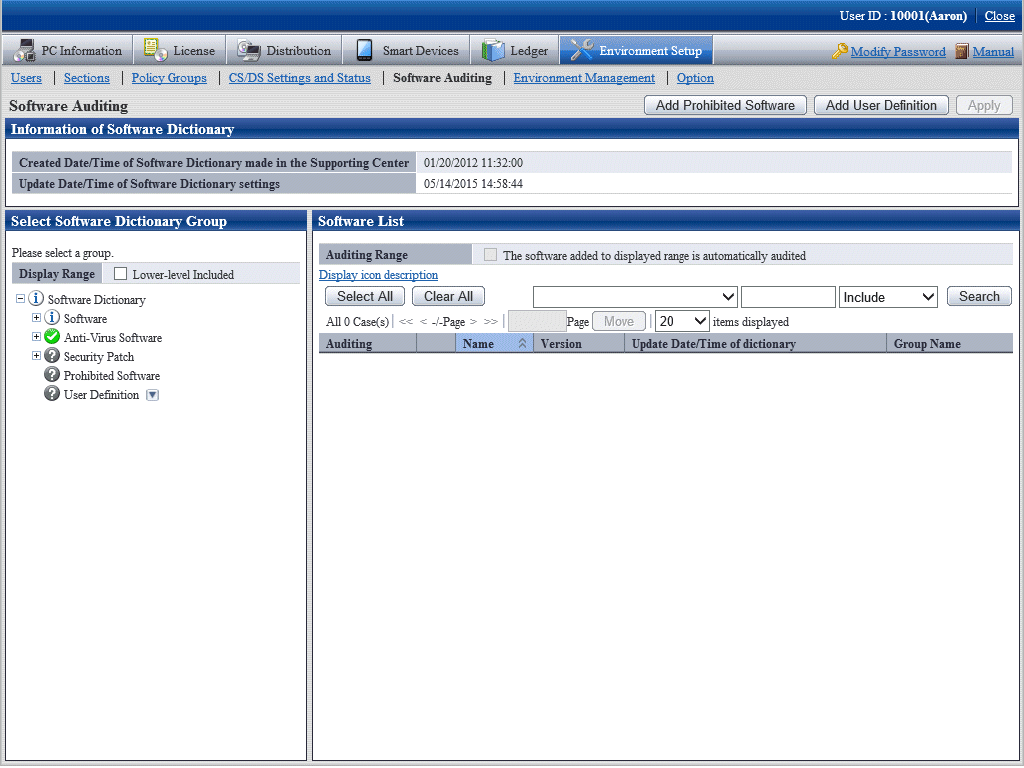
Click the button on the right of User Definition in the tree on the left, and select Add Group from the menu.
The following window is displayed.

Enter the group name and click the OK button.
The created software dictionary group name will be added.
When performing operation for the added group, click the button on the right of the added group to display the menu.
Description of the displayed menu is as follows.
Setting | Description |
|---|---|
Add Group | Specify it to create a group in user definition. Specify a group name using up to 30 fullwidth or 60 halfwidth characters. |
Delete Group | Specify it to delete the group that has been created in user definition. All of the lower-level group and user dictionary will be deleted. |
Move Group | Specify it to move the group that has been created in user definition. All of the lower-level group and user dictionary will be moved. |
Rename Group | Specify it to modify the group name that has been created in user definition. Specify a group name using up to 30 fullwidth or 60 halfwidth characters. |
Define search condition of software
Define the search condition of software.
The procedure is as follows.
Login to the main menu and click Environment settings.
The Environment settings window is displayed.
Click the Software Auditing.
The following window is displayed.

Click the Add user definition button.
The following window is displayed.
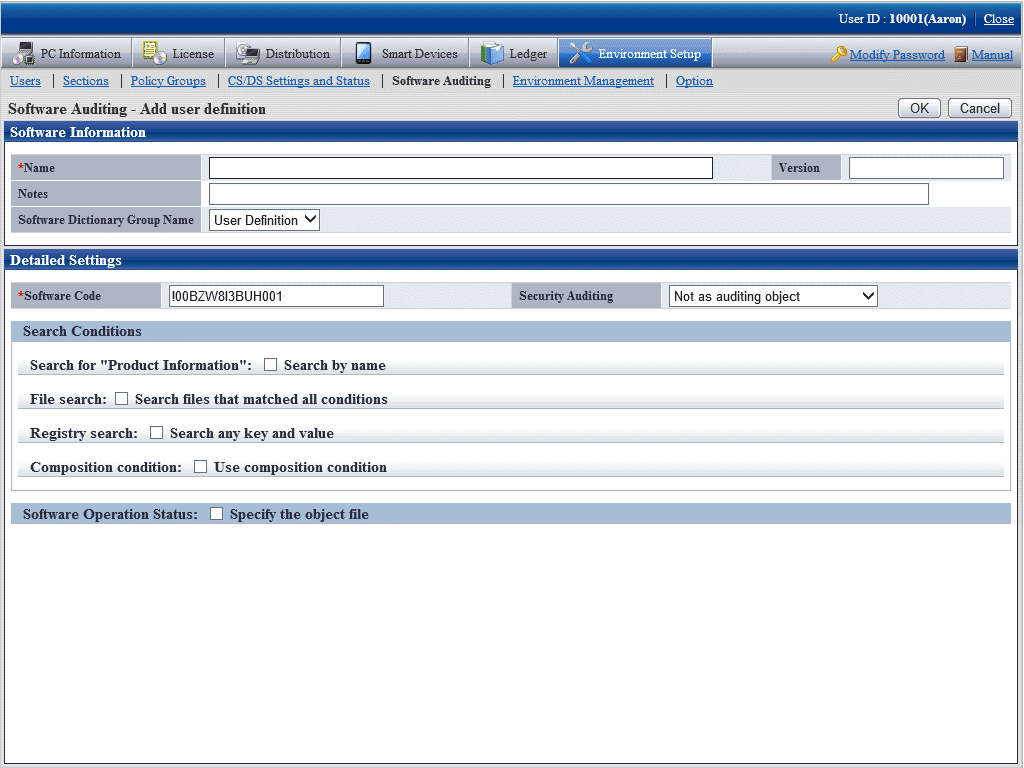
Define the following information.
Software Information
Item | Description |
|---|---|
Name | Specify the name of software to be audited, using up to 128 fullwidth characters or 256 halfwidth characters. This item cannot be omitted. |
Version | Specify the version using up to 32 fullwidth characters or 64 halfwidth characters. |
Notes | Enter the remarks. Enter with 128 multi-byte characters or 256 single-byte characters. |
Software Dictionary Group Name | Select the software dictionary group name to be added into user definition. |
Detailed Settings
Item | Description |
|---|---|
Software Code | It is generated automatically at new registration. To modify, specify with 15 single-byte alphanumeric characters. However, "@" cannot be specified at the beginning. |
Security Auditing | Select whether to set this software to the target of security audit from the following.
|
Search Condition
Specify the search condition of this software.
As the search condition, it involves search from product information, search according to files, search from registry, combined search condition of defined auditing software.
When a certain condition is satisfied, this software will be detected.
Search for Product Information
After Search by name is selected, search will be performed in product information according to the name specified in Name.
File search
After Search files that matched all conditions is selected, setting of file search can be performed.
Each item of file search condition not only can be set manually, but also can be set automatically through command. For details on the command, refer to "dtpfinfo.exe (Getting Detailed Information of Executable File)" of Reference Manual.
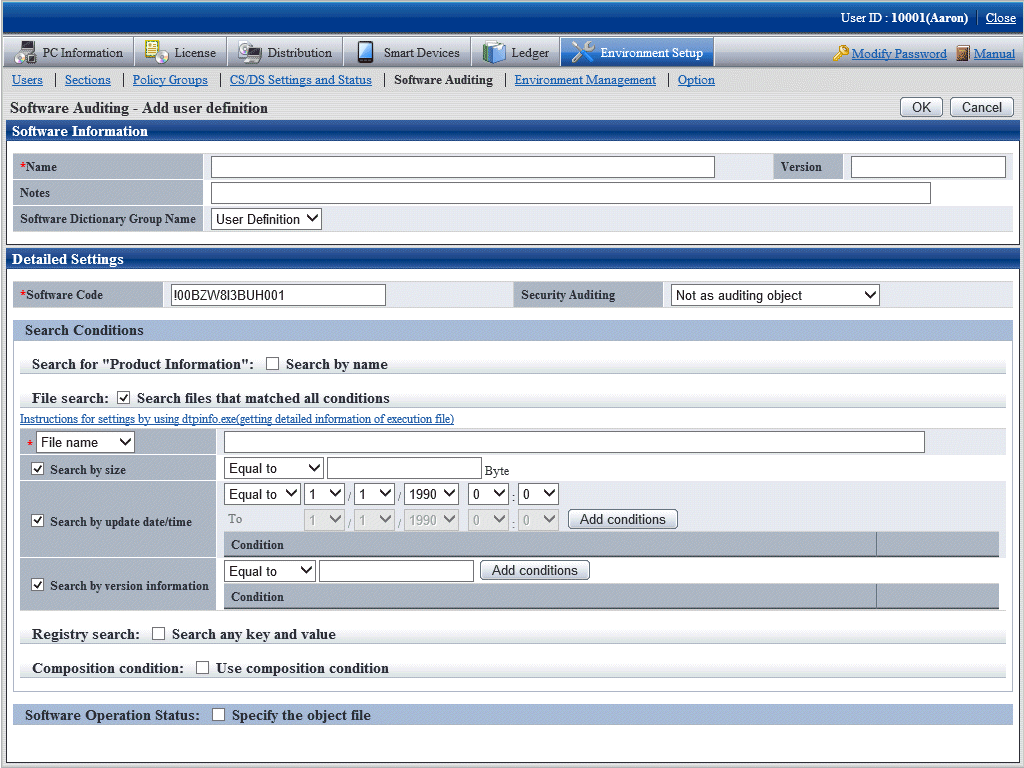
Specify the search condition of file.
Item | Description |
|---|---|
File name/Folder name | Select File name or Folder name from the list and specify the name to be searched using up to 129 fullwidth characters or 259 halfwidth characters. This item cannot be omitted. The following characters cannot be specified. ":", "\", "*", """, "<", ">", "|", "?", "/" |
Search by size | This item is effective when File name is specified, select it when adding the file size as search condition. When specifying the file size in File name, specify a number of up to 13 digits, and select one of Equal, Larger than or Smaller than as the comparison condition of file size. |
Search by update date/ time | Select it when adding file update time as the search condition. Specify the update time of file in File name and select one of Equal to, Above or Below as the comparison condition of update time. When From is selected in the comparison condition, it is required to specify the end date of that period. The date that is larger than the start date of the period should be specified. When Equal to is selected in comparison condition, up to 10 conditions can be registered. The same date and time cannot be specified. |
Search by version information | Select it when adding the version information of file as search condition. The numeric value from 0 to 2147483647 and "." can be specified. In the comparison condition of version information, select one of Equal to or Larger than. When the comparison condition is specified to Equal to, up to 10 conditions can be registered. The same version cannot be specified. In the properties of search file displayed in Windows Explorer, the version information will be displayed in File Version in the Version Information tab. Set the value of version information displayed as above here. |
Registry Search
After Search any key and value is selected, setting of registry search can be performed.
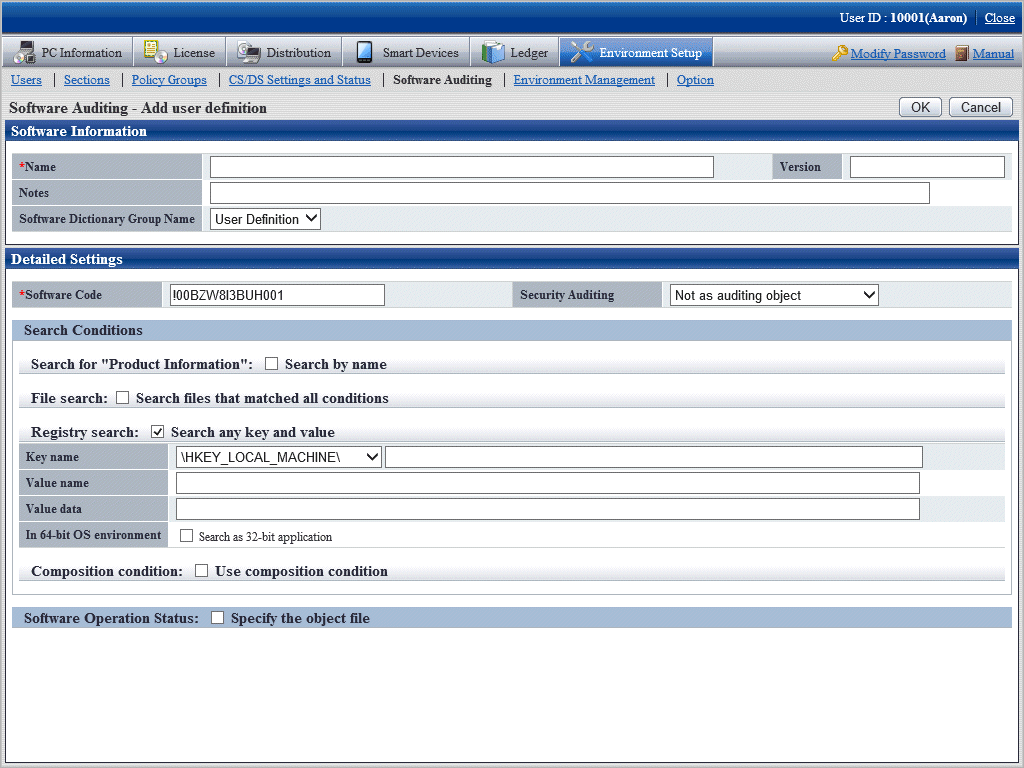
Specify the search condition of registry.
Item | Description |
|---|---|
Key name | Specify the key name of registry using up to 116 fullwidth characters or 233 halfwidth characters. Select the beginning of key name from the list.
|
Value name | Specify the value name of registry using up to 128 fullwidth characters or 256 halfwidth characters. When omitted, search by key name only. |
Value data | Specify the data of registry value using up to 128 fullwidth characters or 256 halfwidth characters. The searchable registry value types are as follows:
When omitted, search by key name and the name of key value only. |
In 64-bit OS environment | Specify registry search operation on the 64-bit OS.
|
Composition condition
Select Use composition condition, combined condition can be set.
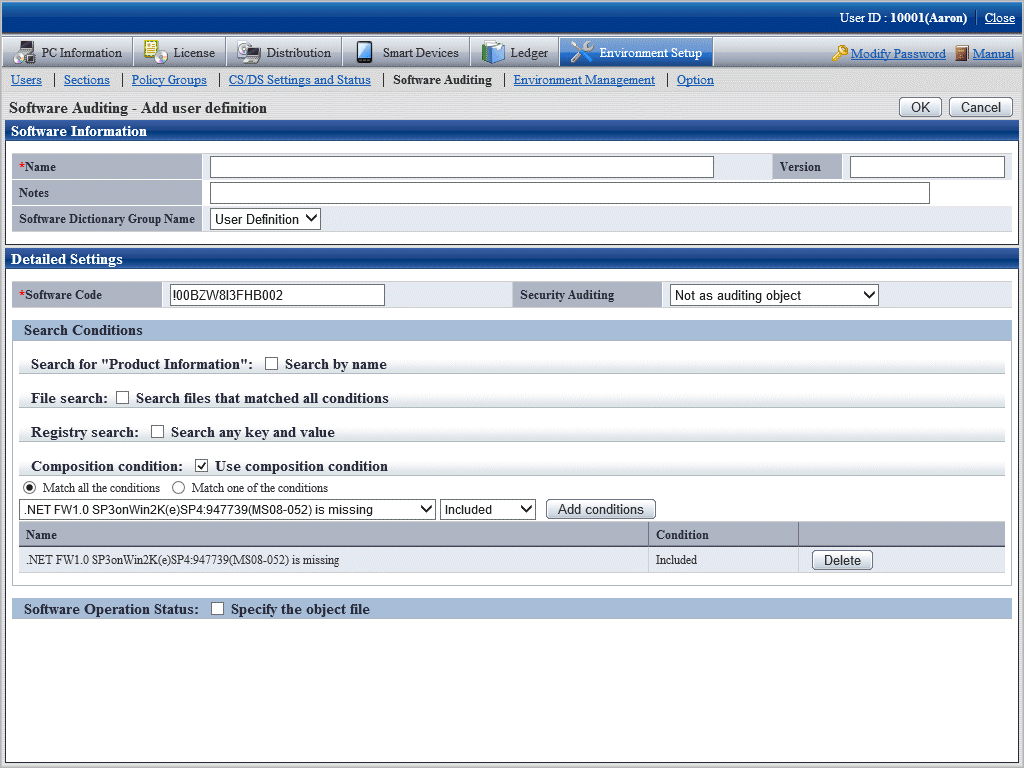
Select the software to be combined from the list, and specify Include or Not Include for the selected software to determine combined condition. Up to 10 combined conditions can be specified.
Item | Description |
|---|---|
Adding conditions button | Add one line of field that can select software. |
Delete button | Delete the software where the line of delete button is located from the combined condition. |
Software Operation Status
Select Specify the object file, the setting of software operation status can be performed.
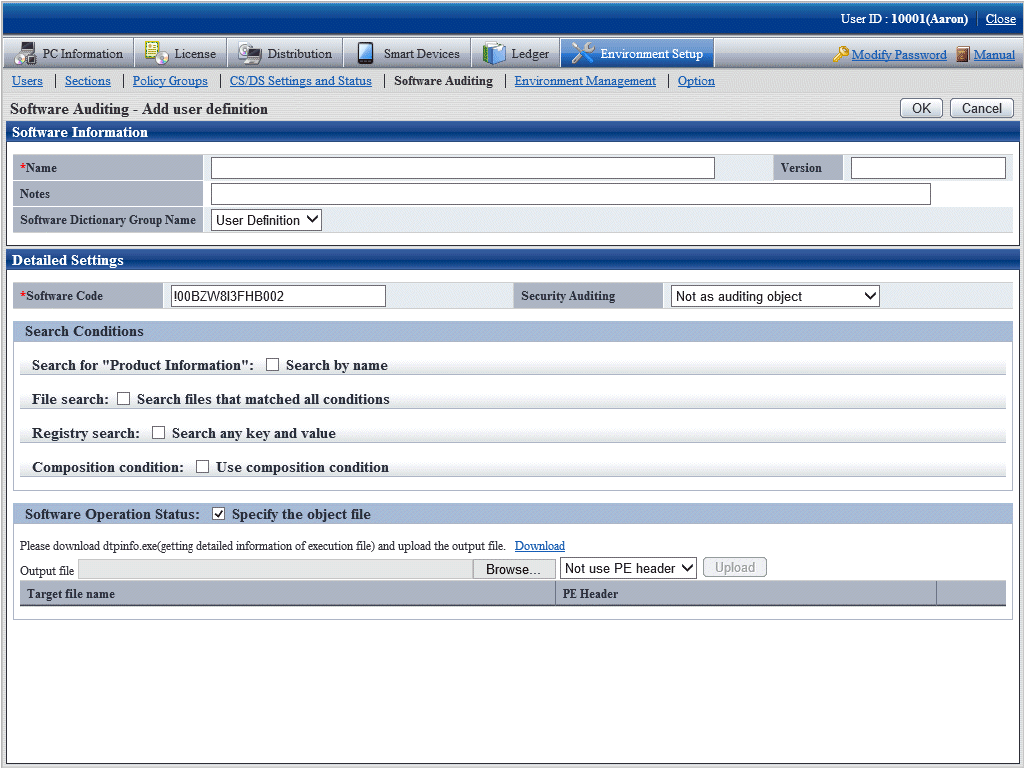
Register the result file of command output to server and software can be registered.
For details on the command, refer to "dtpfinfo.exe (Getting Detailed Information of Executable File)" of Reference Manual.
Item | Description |
|---|---|
Upload button | Register the file specified in the output result file to server. During registration, select whether to specify PE Header for target file to register.
|
Delete button | Delete the file of the line where the delete button is located from the server. |
Target file name | The name of target file to be audited as operation status of software is displayed. |
PE Header | When registering target file according to specified PE Header, it is displayed as Registered. |
In addition, the operation status of the following software cannot be collected.
Software without fixed file name
Software with extension apart from "exe"
Resident software and software without window that is started in service of Windows, etc
Click the OK button.
Put a check in the check box in front of the added user definition
Select the added user definition.
The procedure is as follows.
Login to the main menu and click Environment settings.
The Environment settings window is displayed.
Click the Software Auditing.
The following window is displayed.

In the field on the left, select User Definition.
The added user definition is displayed in the field on the right.
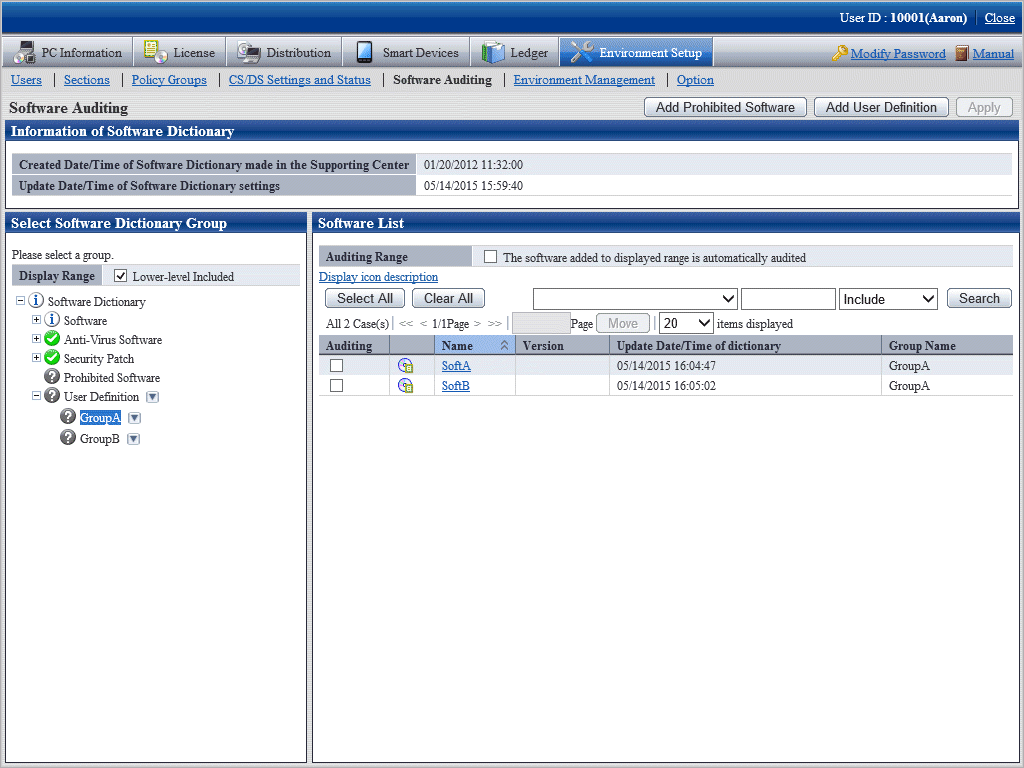
Select the software name to be audited.
Click Apply button, save the selected status.
"User Definition of software dictionary can be created automatically from the information of "Product Information" collected as inventory information from CT.
This "User Definition" is called "User Asset Software Dictionary". "The procedure of creating "User Asset Software Dictionary" is shown as follows.
Confirm the software product that has been installed
Execute the user asset software dictionary creation command
Set user definition of software dictionary
Confirm the software product that has been installed
Confirm the installation status of software product to be audited from the main menu.
Select PC Information > Product Information of the main menu, and refer to the list of software collected from each PC to confirm whether the software product to be audited is displayed.
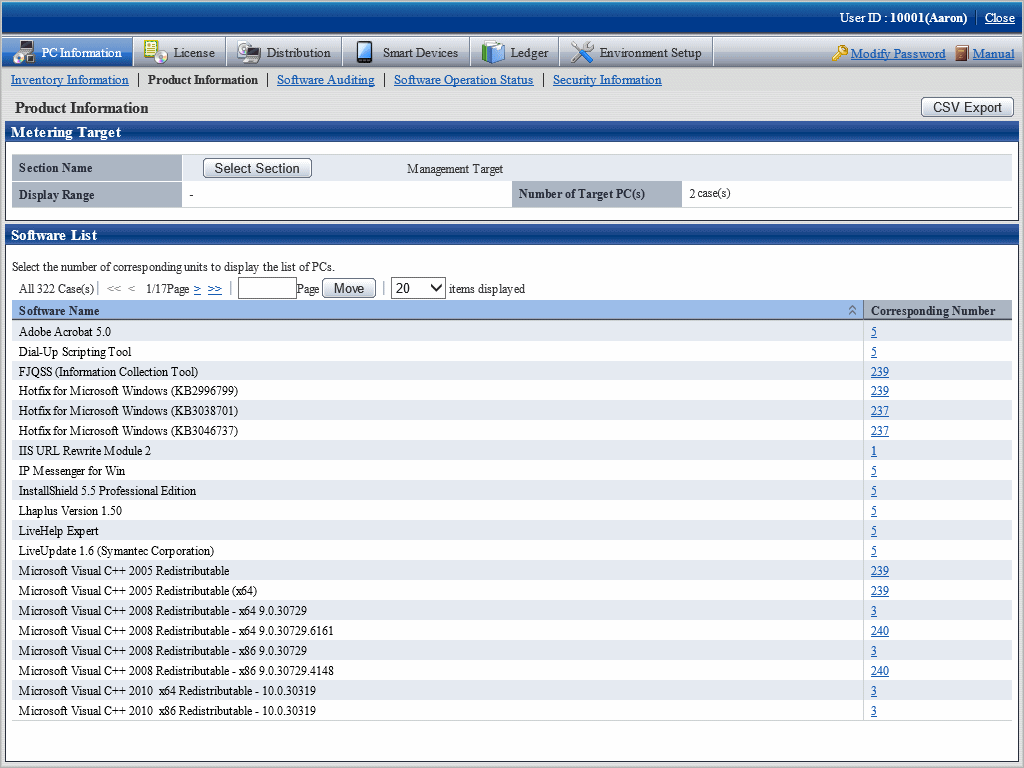
If the software product needs to be audited is not installed, perform the one of following actions.
Install this software product on the PC with CT installed, and collect inventory information.
Install CT on the PC with this software product installed, and collect inventory information.
Execute the user asset software dictionary creation command
Execute the dtplocaldic.exe (user asset software dictionary creation) command.
For details on the dtplocaldic.exe (user asset software dictionary creation) command, refer to Reference Manual.
It is recommended to set the following according to operation method for the timing of command execution.
When creating software dictionary from the inventory information after refining by user ID or PC name
Create the model PC of license management, and execute this command when the Product Information installed to the specified user ID or PC name is modified.
When creating software dictionary from the inventory information of all PCs
Since it is possible to install new software, it is required to register command to the task of Windows and execute the command regularly.
Point
The so-called license management model PC
It indicates that the software product that requires license management has been installed.
Install the software product that requires license management to the specified PC again to collect inventory information. Specify this PC name to execute the user asset software dictionary command and the information volume of user information that requires license management can be reduced.
Set the user definition of software dictionary
Through executing the user asset software dictionary command, the software product displayed in Product Information will be added to the user definition of software dictionary.
The administrator selects the software added to user definition.
The list of added software products will be added to the following location of the main menu in default setting.
Environment Settings > Software Auditing > Software Dictionary > User Definition > Installed Software (Note)
The software product needs to be audited by the administrator.
Note) The location to add software definition is specified in the dtplocaldic.exe (user asset software dictionary creation) command.

The value set for each items of added software definition is shown as follows.

Item | Description |
|---|---|
Name | Software name displayed in Product Information. |
Version | Set VERSION as the initial value. |
Software Dictionary Group Name | In default setting, User Definition (Note) is used as software dictionary group. |
Software code | The code that is generated automatically is set. Format: LLMMDDYYYYIIIII YYYY: 4 digits of western calendar |
Search for "Product Information" | The Search by Name check box is selected. |
Other items | They are not set as initial value. |
Note) The software dictionary group name is specified during the execution of the dtplocaldic.exe (user asset software dictionary creation) command.
Since license management is managed according to the software name displayed in Product Information, if the software product for which the version, license and license form cannot be determined exists in the name displayed in Product Information, this name cannot be used in software license management.
At this time, this situation can be changed through additional setting for other items of the software license definition. For details, refer to "2.2.2 Create User Definition".
Note
The notes for the user definition creation function are shown as follows.
User definition of the software product that is not displayed in Product Information cannot be created.
In following cases, software license definition cannot be created through the user asset software dictionary creation command.
In software dictionary service, when the software license definition of software product with same name exists in "Support Center Definition"
In the previous process of executing the user asset software dictionary creation command, when the software license definition of software product with same name exists in User Definition.
When the software dictionary is provided through software dictionary service, if the software license definition of software product with same name is contained, the software name of User Definition will be renamed.
"Software Name" -> "Software Name (Duplicate)"